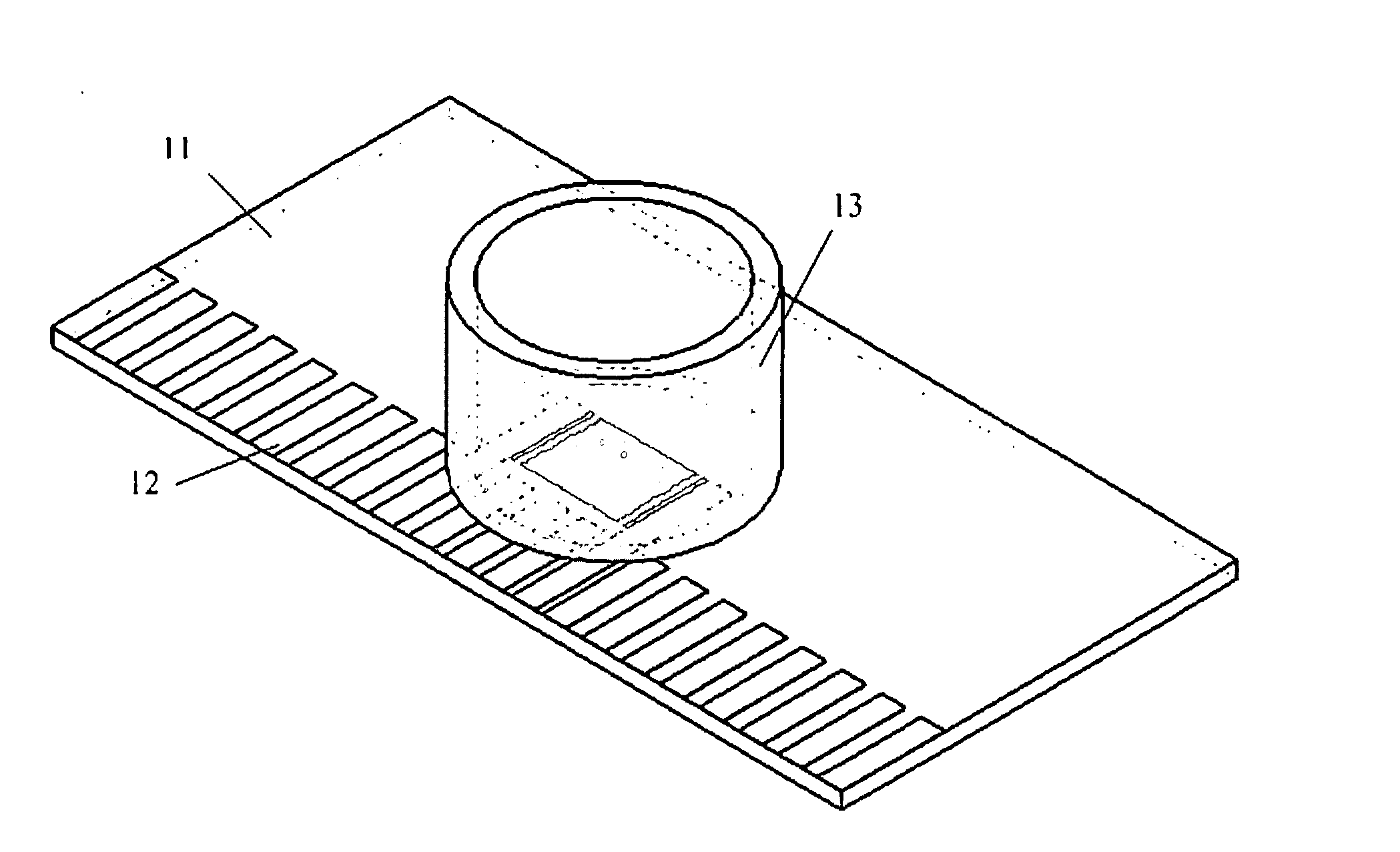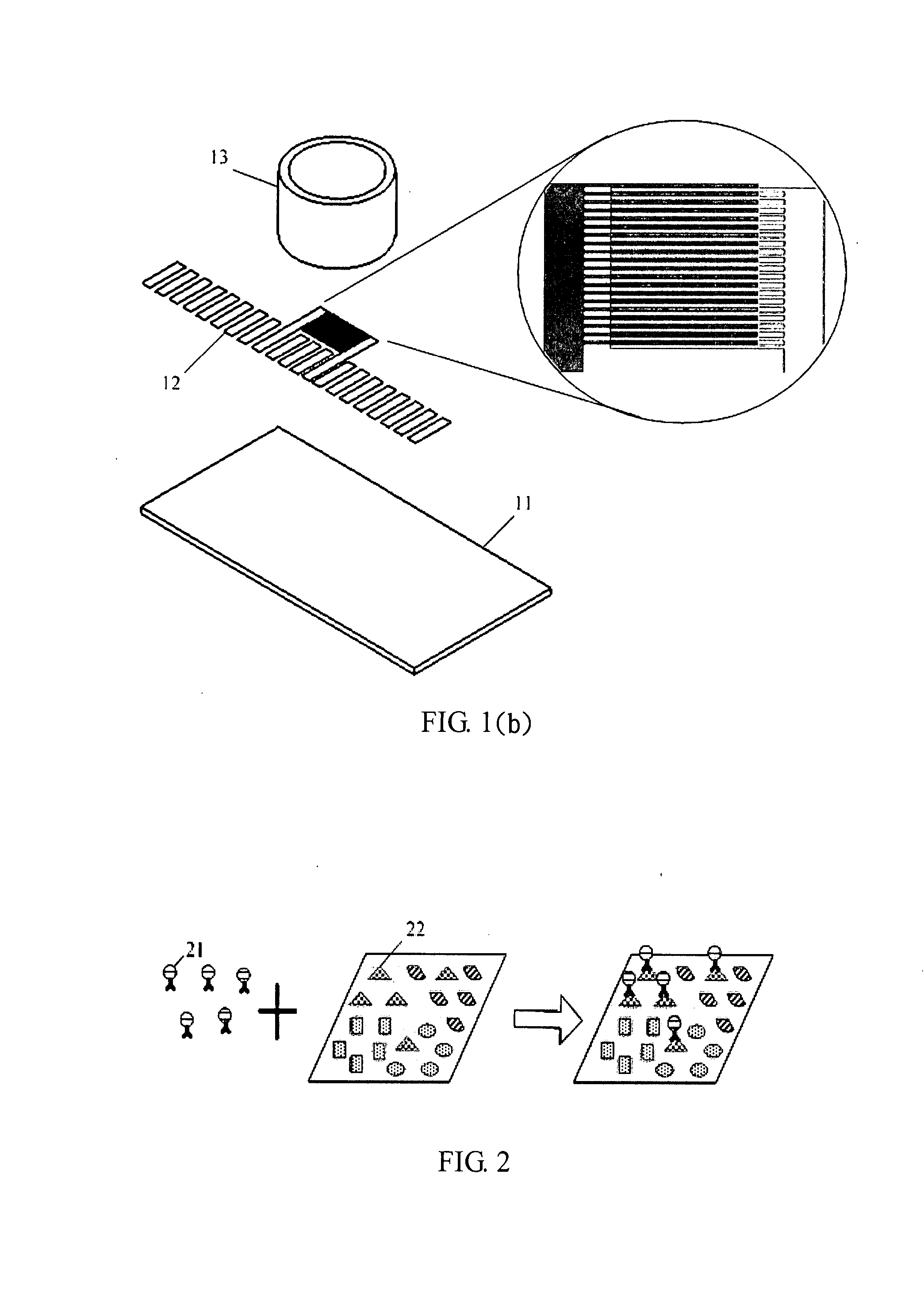Method for detecting bioparticles
- Summary
- Abstract
- Description
- Claims
- Application Information
AI Technical Summary
Benefits of technology
Problems solved by technology
Method used
Image
Examples
embodiment 1
[0065] Directly collect 2 grams of the stool from patients with Salmonella to the conductive fluid of 10 ml, and mix with Salmonella antibody nano-gold for 30 minutes to ensure that the antibody-coated gold nanoparticles have fully integrated with Salmonella. Take out 0.1 ml of the above mixture and drop it in the chip of the present invention, and then apply signals of specific frequency to the comb-shaped electrodes for five minutes. The bottom of the device can further be heated so that it has mild solution convection to increase adsorption opportunities between the attached gold-nanoparticles and comb-shaped electrodes. Take out the supernatant of the mixture and add deionized water to rinse and keep purified adsorbing in the edge of comb-shape electrodes. Impose the comb-shaped electrode with a specific frequency AC signal to continue adsorbing modified pathogens. Connect the comb-shaped electrode with a lock-in amplifier and an impedance analyzer to measure impedance between t...
embodiment 2
[0066] Antibiotics can be divided into two categories: first, bacteriostatic such as chloramphenicol, which hint protein synthesis but germs continue hyperplasia after removal of it; second, bactericidal such as penicillin and congeners, which inhibit the cell expansion but eventually lyse the cell wall and lead to cell death because of increased osmotic pressure inside the cells caused by their consecutive synthesis in the cytosol. When these two mechanisms of antibiotics fail, antibiotic resistance ensues.
[0067] Directly collect 2 grams of the stool from patients with Salmonella to the conductive fluid of 10 ml, and mix with antibody-coated gold nanoparticles until 30 minutes to ensure that the antibody-coated gold nanoparticles have fully integrated with Salmonella. Take out 0.1 ml of the mixture, drop it in the chip of the present invention, and apply signals of specific frequency to the comb-shaped electrodes for five minutes. The bottom of the chip can be further heated so th...
embodiment 3
[0072] As human blood red cells and platelets have no human DNA, white blood cell is the only human cell with the DNA in the blood. The sum of the number of red blood cells and platelets (5,000,000 / μL) is one thousand times more than the number of white blood cell (5,000˜10,000 / μL). Therefore, using solubilization kits to break down the cell membrane directly from the blood sample is difficult to distinguish different cells. Lysis of cells in different species often makes it indistinguishable between bacterial DNA and host DNA. Furthermore, in DNA analysis for genetic or infectious diseases, bacteria and human cells would be lysed simultaneously if no precedent separation between them. Then DNAs from bacteria and hosts may coexist that would make it difficult for judgment and detection.
[0073] In this invention, certain surface protein of white blood cell is utilized to specifically bind to a particular protein with gold-nanoparticles. By only adding the protein-coated nano-particle...
PUM
| Property | Measurement | Unit |
|---|---|---|
| Frequency | aaaaa | aaaaa |
| Force | aaaaa | aaaaa |
| Electrical conductivity | aaaaa | aaaaa |
Abstract
Description
Claims
Application Information
 Login to View More
Login to View More - R&D
- Intellectual Property
- Life Sciences
- Materials
- Tech Scout
- Unparalleled Data Quality
- Higher Quality Content
- 60% Fewer Hallucinations
Browse by: Latest US Patents, China's latest patents, Technical Efficacy Thesaurus, Application Domain, Technology Topic, Popular Technical Reports.
© 2025 PatSnap. All rights reserved.Legal|Privacy policy|Modern Slavery Act Transparency Statement|Sitemap|About US| Contact US: help@patsnap.com



